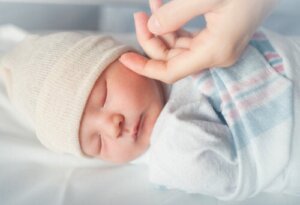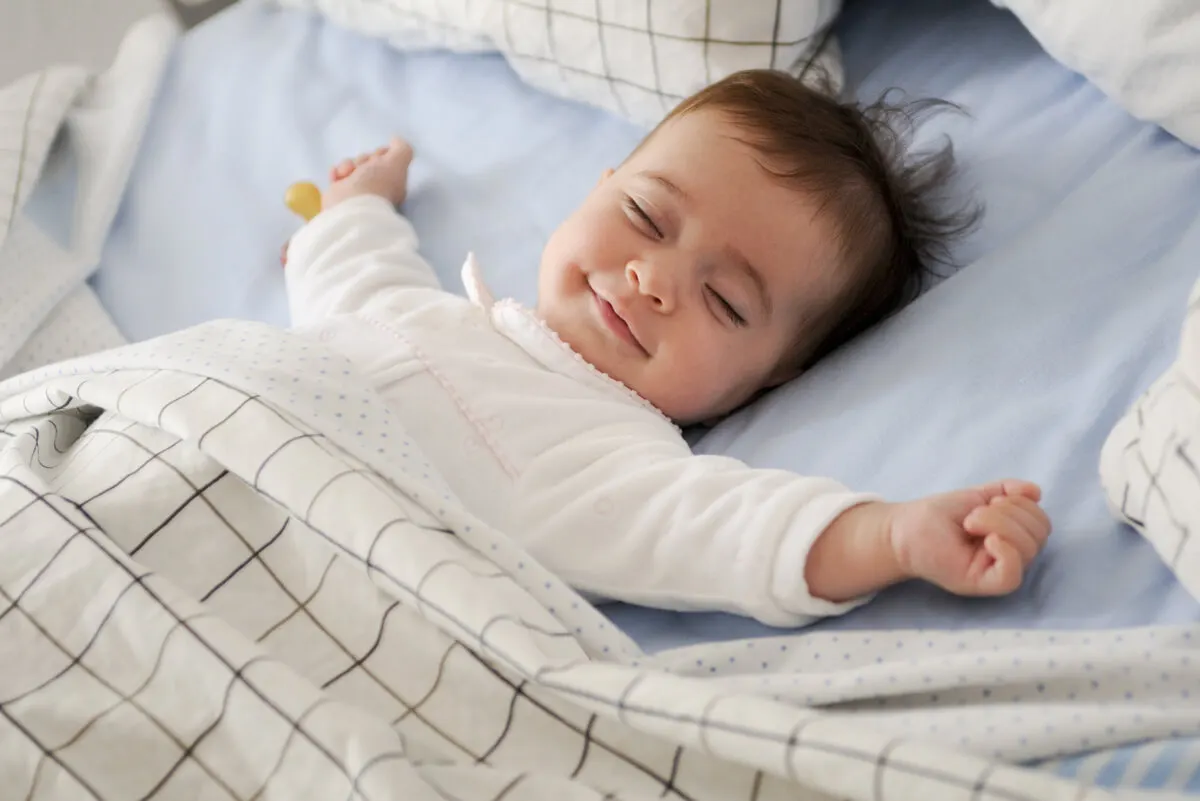9 Tips to Keep Your Baby Warm on Cold Nights

Keeping your baby warm on cold nights is essential to help him regulate his or her temperature. Newborns are used to the warmth of the womb and external factors have a significant impact.
Indoors and outdoors, attention must be paid to the details that keep your child warm at night. In this article, we’ll take a look at the importance of keeping your child tucked in and the right ways to do it.
Why is it important to keep your baby warm on cold nights?
Babies are so vulnerable that they lose body heat four times faster than an adult. In a cold environment, children in months without a coat are more prone to colds and cases of flu.
Also, exposure to low temperatures in winter may dry out your baby’s skin. In these cases, it’s best that they wear clothing made of cotton or linen, as these fabrics are kind to the breathing of the infant dermis.
Other more serious scenarios are frostbite and hypothermia. If health conditions are worsened by the cold, there is an increased risk of rheumatic, cardiac or respiratory diseases.
Keep in mind that the neurovascular response system of infants doesn’t match the development of older children or adults. It’s difficult for them to fight the cold and, by crying, they’re often unable to communicate their feelings.
Keeping a month-old baby warm at night means that he or she will sleep without any discomfort.
Temperature guidelines for homes with babies
A guide for parents issued by the Spanish Association of Pediatrics states that the temperature in a baby’s room should be between 20 and 22°C.
The way to make sure it’s the right temperature is to use a room thermometer. An extra trick is to sense if the cold is tolerable for an adult wearing light clothing.
In addition, parents can touch the back of the baby’s neck, neck, legs, or arms. These parts offer a better reference than the hands or feet, because the latter are almost always cold, due to the immaturity of the peripheral circulatory system.

A better rest will be achieved if the baby is not cold at night.
Recommendations to keep your baby warm on cold nights
Warming the baby’s body doesn’t mean that you will take several blankets to cover him/her. On cold nights, it’s best not to leave the house with your child. However, inside your home, it’s a good idea to implement the following suggestions.
Like this article? You may also like to read: What’s “Baby Talk” and How Does it Benefit Babies?
1. Warm up their bed
Putting a plastic bottle filled with hot water on the crib mattress provides warmth for the baby to fall asleep. Do this half an hour before putting the baby to bed.
Do not put the baby to bed without checking with the palm of your hand that the level of heating reached by the mattress is appropriate. Remove this heater, and then your baby will get to rest warmly on cold nights.
2. Dress your baby appropriately
Put them in clothes that are easy to put on and take off. Generally, infants tend to be dressed with an additional layer to the one worn by older children.
However, the Department of Health and Consumption of the Government of Aragon points out that babies do not require more layers of clothing than an adult. They claim that too much warm clothing is as harmful as too little clothing.
The right thing to do would be comfortable clothing that covers what is necessary. Alternatives for cold nights include onesie pajamas.
3. Wrap him or her up or lay him or her down in a sleeping bag
Sleeping bags are practical and contribute to a restful and comfortable sleep. Wrapping him in a blanket also helps him sleep comfortably.
However, don’t go overboard with the thickness, as the American Academy of Pediatrics notes that sweating, rashes and flushed cheeks may result.
4. Use climate control equipment
These days, it’s easy to find accessories that can help climate-control rooms. Heating pads that you heat in the microwave and then transfer to the bed are among the options. Similarly, the market offers the following:
- Portable thermal blankets that don’t hinder the baby’s movements.
- Heat lamps for the bed.
- Fireproof heaters.
We think you may be interested in reading this, too: When and How to Add Cucumber to Your Baby’s Diet?
5. Choose a firm, thin mattress
Thick mattresses get a lot of cold air in, increasing the risk of making your child sick. This happens because they’re made of soft materials.
Thin, firm mattresses, on the other hand, benefits body temperature. Prepare them with a sheet that fits the crib and is waterproof.
6. Put them in hats and mittens
The head and hands are two places where you provide warmth quickly. Cover the baby with a hat and cotton mittens. A pair of socks wouldn’t hurt to keep his feet warm.
7. Place the crib in a strategic position
When it comes to preventing the breeze from blowing, it works to place the crib or bassinet well away from areas where there are conditions such as those listed below:
- Fans
- Air vents
- Exterior walls
- Drafty windows
- Doors through which the cold can enter
8. Set the thermostat
The thermostat in the house needs to be set at an acceptable level. Defining how many degrees depends on the characteristics of the property.
Although we have already mentioned an optimal temperature range for the newborn, still make sure to consult with your pediatrician about the beneficial range, especially if the child has any medical condition.

The temperature of the home should be regulated according to a criterion of comfort for the members of the household, without going to extremes.
9. Prepare a warm bath
On cold nights, baby baths should be short – no more than 10 minutes, and preferably with warm water. When taking him or her out, have a towel and sleep clothes previously warmed with a thermal source.
This way, your child will not perceive the sudden change in temperature. Check that the clothes are not excessively warm.
Is there any risk in overdressing your baby?
There is a danger that overdressed babies are exposed to overheating. This condition is linked to sudden infant death syndrome, which is more prevalent during the cold months, as reported by the U.S. Department of Health and Human Services.
While babies should be tucked in when they sleep, they should not be overdressed. By following the recommendations outlined here, your child will have a warm and safe night’s sleep.
All cited sources were thoroughly reviewed by our team to ensure their quality, reliability, currency, and validity. The bibliography of this article was considered reliable and of academic or scientific accuracy.
- Cuídame: guía para madres y padres. Departamento de Salud y Consumo. Gobierno de Aragón. pp. 29. España. https://www.aeped.es/sites/default/files/3-cuidame_esp.pdf
- Guía Práctica para Padres. Desde el nacimiento hasta los 3 años. pp. 51. Asociación Española de Pediatría. http://enfamilia.aeped.es/sites/enfamilia.aeped.es/files/guia_practica_padres_aep_1.pdf
- Investigación sobre otros factores de riesgo de SIDS. Departamento de Salud y Servicios Humanos de Estados Unidos. https://safetosleep.nichd.nih.gov/research/science/other#f13
- Recomendaciones de un sueño seguro. Academia Americana de Pediatría. Estados Unidos; 2020. https://www.healthychildren.org/English/ages-stages/baby/diapers-clothing/Pages/Swaddling-Is-it-Safe.aspx
This text is provided for informational purposes only and does not replace consultation with a professional. If in doubt, consult your specialist.








